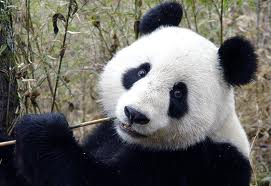The panda is a bear native to the central-western and south western China. It is easily recognized by its large, distinctive black patches around the eyes, over the ears, and across its round body. Though it belongs to the order Carnivora, the panda's diet is 99% bamboo. Pandas in the wild will occasionally eat other grasses, wild tubers, or even meat in the form of birds, rodents or carrion. In captivity they may receive honey, eggs, fish, yams, shrub leaves, oranges, or bananas along with specially prepared feed.
The giant panda lives in a few mountain ranges in central China, mainly in the Sichuan province, but also in the Shaanxi and Gansu provinces. Due to farming, deforestation and other development, the panda has been driven out of the lowland areas where it once lived.
The panda is a conservation reliant endangered species. A 2007 report shows 239 pandas living in captivity inside China and another 27 outside the country. Wild population estimates vary; one estimate shows that there are about 1,590 individuals living in the wild, while a 2006 study via DNA analysis estimated that this figure could be as high as 2,000 to 3,000. Some reports also show that the number of pandas in the wild is on the rise. However, the IUCN does not believe there is enough certainty yet to reclassify the species from Endangered to Vulnerable.
While the dragon has historically served as China's national emblem, in recent decades the panda has also served as an emblem for the country. Its image appears on a large number of modern Chinese commemorative silver, gold, and platinum coins. Though the panda is often assumed to be docile, it has been known to attack humans, presumably out of irritation rather than predation.
The giant panda has a black-and-white coat. Adults measure around 1.2 to 1.8 meters (4 to 6 ft) long and around 75 centimeters (2 ft 6 in) tall at the shoulder. Males can weigh up to 150 kilograms (330 lb). Females (generally 10–20% smaller than males) can weigh up to 125 kilograms (280 lb).
The giant panda has a body shape typical of bears. It has black fur on its ears, eye patches, muzzle, legs, arms and shoulders. The rest of the animal's coat is white. Although scientists do not know why these unusual bears are black and white, some speculate that the bold coloring provides effective camouflage in its shade-dappled snowy and rocky surroundings. The giant panda's thick, wooly coat keeps it warm in the cool forests of its habitat. The giant panda has large molar teeth and strong jaw muscles for crushing tough bamboo.
The giant panda's paw has a "thumb" and 5 fingers; the "thumb" is actually a modified sesamoid bone, which helps the giant panda to hold bamboo while eating. Stephen Jay Gould discusses this feature in his book of essays on evolution and biology, The Panda's Thumb.
The giant panda's tail, measuring 10 to 15 centimeters (4 to 6 in), is the 2nd longest in the bear family. The longest belongs to the Sloth Bear.
The giant panda usually lives around 20 years in the wild and up to 30 years in captivity.
The giant panda lives in a few mountain ranges in central China, mainly in the Sichuan province, but also in the Shaanxi and Gansu provinces. Due to farming, deforestation and other development, the panda has been driven out of the lowland areas where it once lived.
The panda is a conservation reliant endangered species. A 2007 report shows 239 pandas living in captivity inside China and another 27 outside the country. Wild population estimates vary; one estimate shows that there are about 1,590 individuals living in the wild, while a 2006 study via DNA analysis estimated that this figure could be as high as 2,000 to 3,000. Some reports also show that the number of pandas in the wild is on the rise. However, the IUCN does not believe there is enough certainty yet to reclassify the species from Endangered to Vulnerable.
While the dragon has historically served as China's national emblem, in recent decades the panda has also served as an emblem for the country. Its image appears on a large number of modern Chinese commemorative silver, gold, and platinum coins. Though the panda is often assumed to be docile, it has been known to attack humans, presumably out of irritation rather than predation.
The giant panda has a black-and-white coat. Adults measure around 1.2 to 1.8 meters (4 to 6 ft) long and around 75 centimeters (2 ft 6 in) tall at the shoulder. Males can weigh up to 150 kilograms (330 lb). Females (generally 10–20% smaller than males) can weigh up to 125 kilograms (280 lb).
The giant panda has a body shape typical of bears. It has black fur on its ears, eye patches, muzzle, legs, arms and shoulders. The rest of the animal's coat is white. Although scientists do not know why these unusual bears are black and white, some speculate that the bold coloring provides effective camouflage in its shade-dappled snowy and rocky surroundings. The giant panda's thick, wooly coat keeps it warm in the cool forests of its habitat. The giant panda has large molar teeth and strong jaw muscles for crushing tough bamboo.
The giant panda's paw has a "thumb" and 5 fingers; the "thumb" is actually a modified sesamoid bone, which helps the giant panda to hold bamboo while eating. Stephen Jay Gould discusses this feature in his book of essays on evolution and biology, The Panda's Thumb.
The giant panda's tail, measuring 10 to 15 centimeters (4 to 6 in), is the 2nd longest in the bear family. The longest belongs to the Sloth Bear.
The giant panda usually lives around 20 years in the wild and up to 30 years in captivity.


0 comments